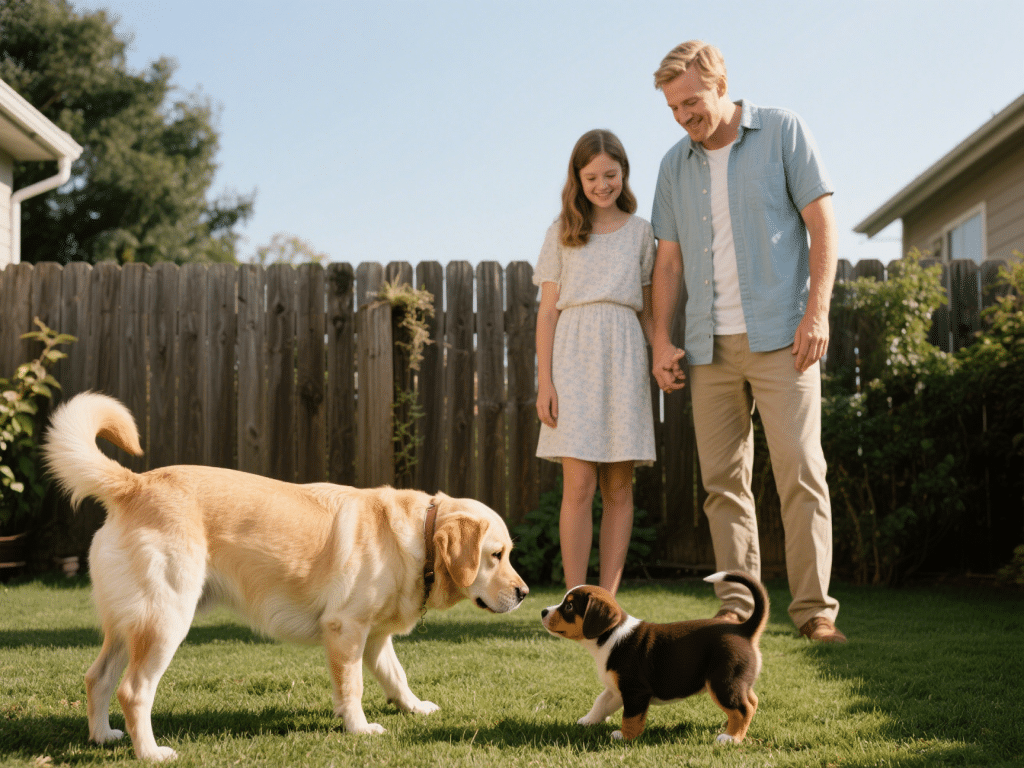Introduction
Bringing a new puppy into a household that already has cats can be rewarding but requires careful management. Cats and puppies have different communication styles—proper introductions minimize stress, reduce territorial conflicts, and establish a peaceful coexistence.
1. Pre-Arrival Preparations
Designated Safe Spaces for Cats: Before bringing the puppy home, set up elevated shelves, cat trees, or separate rooms where cats can retreat. Provide familiar bedding and toys to reduce anxiety.
Puppy-Proof Cat Areas: Ensure crates and feeding stations remain inaccessible to the puppy. Place cat litter boxes in areas the puppy cannot reach.
Scent Swapping: Rub a soft cloth on the puppy’s muzzle and paws, then place it near the cats’ resting areas (and vice versa). Familiarizing each species with the other’s scent reduces novelty stress.
2. Initial Separation & Visual Introductions
Use a Barrier: Introduce the puppy and cats through a baby gate or cracked door so they can see and sniff without physical contact. Observe body language:
Cats: Ears pointed forward or sideways, relaxed posture.
Puppy: Loose, wagging tail (appropriate curiosity).
Short, Positive Sessions: Start with 5–10 minute supervised visual exposures while both animals are calm. Reward both with treats and praise to create positive associations.
3. First Supervised In-Person Meeting
Puppy on Leash or in Crate: Keep the puppy restrained to prevent lunging or chasing. Allow the cat to approach on its own terms. If the cat retreats, do not force interaction.
Maintain Calm Energy: Speak softly; avoid sudden movements. Use treats to reward calm behavior from both parties.
Limit Distractions: Conduct the meeting in a neutral room with no loud noises or other pets. Keep all doors closed to prevent either from escaping into unsecured zones.
4. Gradual Integration Steps
Short, Frequent Interactions: Multiple brief exposure sessions are better than one prolonged meeting. Gradually lengthen interaction times as both become more comfortable.
Off-Leash Exploration (Supervised): Once the puppy responds reliably to “sit,” “stay,” and “leave it,” allow off-leash investigation under close supervision. Keep a leash nearby in case you need to interrupt.
Reinforce Desired Behaviors: Reward the puppy for calm behavior (e.g., sniffing quietly) and the cat for non-aggressive responses. Use treats, petting, or verbal praise.
5. Managing Tension and Avoiding Conflict
Watch Vocalizations:
Hissing or Growling (Cat): Indicates fear or discomfort. Intervene by redirecting both with treats and separate them to a safe distance.
Barking or Lunging (Puppy): Interrupt with a gentle “no” and redirect to a toy or a “sit” command.
Provide Escape Routes: Ensure cats have vertical spaces or open doors to back away if overwhelmed. Never corner a cat—this can provoke defensive aggression.
Separate During High-Stress Times: Meal times, crate time, or when one pet is resting. Prevent unsupervised encounters until trust builds.
6. Enrichment for Cats and Puppy
Cat Enrichment: Continue providing scratching posts, puzzle feeders, and elevated perches.
Puppy Training: Introduce basic obedience early—commands like “sit,” “down,” and “leave it” help control excitement around cats.
Individual Attention: Spend quality one-on-one time with each pet daily to prevent jealousy and reinforce positive behavior.
7. Long-Term Coexistence Strategies
Consistent Routine: Regular feeding, play, and rest schedules reduce anxiety. Keep cat and puppy routines as consistent as possible.
Monitor Body Language Regularly: Subtle changes—such as flattened ears on the cat or stiff posture in the puppy—may indicate tension requiring intervention.
Reevaluate As Needed: If conflicts persist beyond 2–3 weeks, consult a certified animal behaviorist for tailored guidance.
Conclusion
Introducing a new puppy into a home with resident cats requires patience, planning, and careful observation. Phased, supervised interactions—beginning with scent swapping and visual introductions—set the stage for positive relationships. By respecting each animal’s space, reinforcing calm behavior, and providing enrichment, you foster a harmonious household where both cats and puppies can thrive together.
Title: Creating a Balanced Raw Diet for Your Dog: A Starter Guide
Keywords: balanced raw dog diet, raw feeding dog guide
Description: Starter guide to crafting a balanced raw diet for dogs, emphasizing nutrition, safety, and meal planning.
Prompt: A Caucasian pet nutritionist preparing a raw diet meal for a healthy adult dog in a modern kitchen, fresh ingredients visible, realistic, 1024×768, file size <300K
Body:
Introduction
Feeding a balanced raw diet, often referred to as prey model or BARF (Biologically Appropriate Raw Food), can support optimal canine health and reflect a dog’s evolutionary dietary needs. This starter guide outlines essential components, nutritional ratios, safety protocols, and meal-planning tips to ensure your dog thrives on raw nutrition.
1. Core Components
Muscle Meat (70% of diet): Supply high-quality protein and vital amino acids—choose lean cuts of beef, chicken, turkey, or pork.
Edible Bones (10–15% of diet): Uncooked, meaty bones like chicken wings or turkey necks deliver calcium, phosphorus, and dental benefits through natural chewing. Avoid cooked bones to prevent splintering.
Organ Meat (10–15% of diet): Liver, kidney, and heart are nutrient-dense sources of vitamins A, D, and B complex. Limit liver to 5–10% of the diet to avoid hypervitaminosis A.
Fruits & Vegetables (5–10% of diet): Optional. Pureed carrots, spinach, pumpkin, or blueberries add fiber, antioxidants, and micronutrients. Dogs primarily metabolize protein, making produce secondary.
Supplements: Omega-3 fish oil, taurine (depending on ingredient choices), and powdered kelp or eggshell (if feeding boneless meats) help fill nutritional gaps.
2. Nutritional Ratios & Requirements
Protein & Fat: Aim for 20–25% protein and 10–15% fat on a calorie basis. Active or working dogs may require higher fat.
Calcium-to-Phosphorus (Ca:P) Ratio: Target between 1.1:1 and 1.5:1. Edible bones usually balance this ratio; boneless feeders must supplement accordingly (e.g., 1 tsp crushed eggshell per pound of meat).
Micronutrients: Trace minerals like zinc, iron, and vitamins E and D are critical. Some feeders add canine-specific powdered premixes to ensure completeness.
3. Ingredient Sourcing & Selection
Human-Grade vs. Pet-Grade: Human-grade meat from grocery stores or butchers reduces contamination risk. Avoid expired or low-quality cuts labeled solely for pet consumption.
Organic vs. Conventional: Organic meats minimize antibiotic and hormone exposure; however, quality sourcing is priority.
Safe Bone Choices: Offer appropriately sized bones to prevent choking or dental fractures—turkey necks for medium breeds, meaty rabbit carcasses or chicken wings for small dogs.
4. Food Safety & Hygiene
Storage: Keep raw components refrigerated at 32–40°F (0–4°C). Use within 24–48 hours or freeze in portioned meal-size bags at –0°F (–18°C). Thaw in the refrigerator, never at room temperature.
Sanitation: Clean cutting boards, utensils, and bowls with hot, soapy water and disinfectants. Wash hands thoroughly before and after food preparation.
Avoid Cross-Contamination: Designate separate prep areas for raw pet food and human foods.
5. Transitioning to Raw
Gradual Introduction: Mix 25% raw with 75% current diet, increasing raw by 25% each week. Monitor stool quality, energy levels, and overall health.
Monitor Stool & Digestion: Firm, small stools indicate appropriate fat/protein balance. Loose stools or diarrhea suggest too much fat; overly dry stools may indicate lack of moisture or fiber. Adjust ingredient ratios accordingly.
6. Meal Planning & Feeding Guidelines
Daily Caloric Needs: Adult dogs typically consume 2–3% of their ideal body weight daily. Active or working breeds may need up to 4–5%.
Feeding Frequency: Puppies require 3–4 small meals daily; adult dogs benefit from 2 meals per day.
Portion Control: Weigh each portion precisely using a kitchen scale. Track weight changes weekly to adjust feeding amounts.
7. Common Pitfalls & How to Avoid Them
Imbalanced Meals: Feeding only muscle meat leads to calcium deficiency. Always include bone or a calcium-rich supplement.
Overfeeding Treats or Table Scraps: Extra calories disrupt balanced nutrition. Limit to <10% of daily intake, focusing on lean proteins.
Ignoring Veterinary Guidance: Work with your veterinarian or a board-certified veterinary nutritionist—especially for dogs with health conditions (kidney disease, pancreatitis, etc.).
8. Monitoring & Adjustments
Biannual Veterinary Checkups: Bloodwork, urinalysis, and body condition assessments ensure organ function and detect deficiencies.
Coat & Skin Health: A glossy coat and supple skin reflect adequate fatty acid intake. Dull or flaky coat suggests a need for omega-3 supplementation.
Behavior & Energy: Increased vitality and balanced energy levels indicate balanced macros; lethargy or hyperactivity may mean imbalanced fats or proteins.
Conclusion
A balanced raw diet for dogs can deliver improved digestion, enhanced coat condition, and greater energy. By combining muscle meat, edible bones, organ meat, and optional produce in appropriate ratios—and strictly adhering to safety and hygiene protocols—you can provide a nutritious, species-appropriate diet. Regular veterinary collaboration ensures long-term health and success on your dog’s raw-feeding journey.










Comments on "Tips for Introducing a New Puppy into a Home with Cats" :